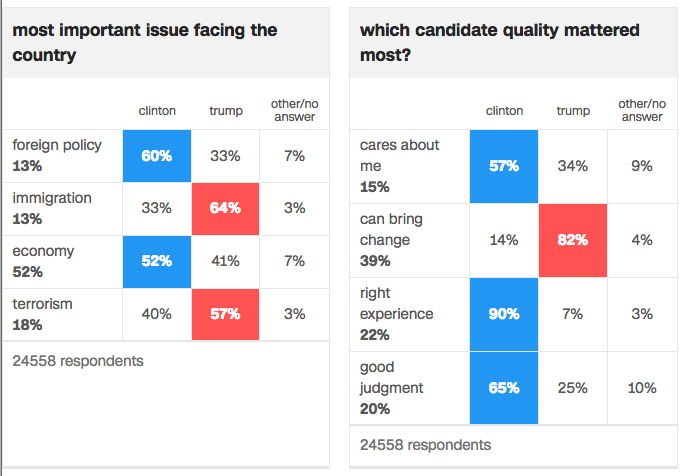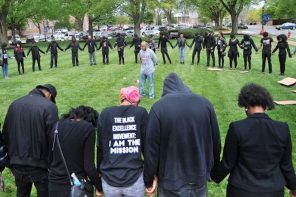You ever hear the saying, “same shit, different day”? I’m reminded of that very phrase a lot in the religion-and-politics beat. A lot.
Exhibit A: an op-ed in today’s New York Times declaring “To Win Again, Democrats Must Stop Being The Abortion Party.” The argument is pretty much exactly what you think it will be: the well-worn chestnut about Democrats needing to moderate on reproductive rights in order to reach out to swing voters, Catholics in particular. And yes, I guess there is a certain amount of logic to this, in the sense that if Democrats would only just stand up for working-class white men and forget all this business about being the party of defending women’s right to control their own bodies and racial minorities not to be second-class citizens, they could draw a lot of support from Republican-leaning voters. A lot.
Except, no, not even that daffy logic works. Here’s why, in two charts:
You might be able to make an argument that part of the “change” voters said they wanted to see was a different approach to abortion, but guess what? It doesn’t turn up on the list of top priorities, not even close—and the national result is mirrored in Michigan and Ohio and Pennsylvania and Wisconsin. It’s the same thing election after election: if you ask voters what it’s all about, they’ll tell you the economy, foreign policy, and terrorism, not necessarily in that order.
Oh, and by the way? Clinton didn’t apologize for her position on abortion because she didn’t have to. She, like many women in the Democratic Party, doesn’t believe that there’s anything to apologize for or complicated in saying that they believe women should have access to a broad range of reproductive services, including abortion. I’m not sure why it’s always incumbent on those who are in favor of choice to soothe the upset nerves of those who aren’t. Perhaps those who don’t believe in abortion need to accommodate themselves to the reality that not everyone agrees with them, and that even many those who may not approve of abortion aren’t particularly interested in legislating their beliefs. It’s way past the point where this should be obvious, having been a bone of contention since 1992 at the very least.
Anyway, Exhibit B: according to Reuters, the Religious Left is emerging as a political force in the Trump era.
Oh, yeah? Is that like the time they were emerging in 2006?
Or 2008?
Or 2009?
Or 2013?
Those are links I found in about 30 seconds’ worth of googling. Some time spent with Lexis-Nexis would no doubt turn up many more. In case the point is not obvious, the same people have been selling the same story about this Religious Left that’s going to be here any minute now! for a very long time. Hell, I’ve even been a part of some of those efforts. And yet the movement never does arrive.
It never arrives because the left (or at least the Democratic party) is too diverse and its priorities too different for anything like a mirror-image of the Religious Right to coalesce. Also, nobody on the left wants anything like the obnoxious authoritarians of the Religious Right to appear on the left. Democrats are secular-minded and they like it like that, thank you very much. (If you don’t believe me, check out the book sales of religious progressives, mine included.)
And, yeah, turns out nobody really gives a damn about their pastors’ view on social or political issues.
So no, there isn’t really a Religious Left to emerge beyond the groups mentioned in the Reuters piece pushing out press releases and holding rallies in D.C. They may have been “astounded” when 300 clergy showed up to protest the AHCA, but that does not a movement make, sorry. Nor can the number of churches offering to provide sanctuary to asylum-seekers and undocumented workers, since communities of all stripes—conservative and liberal—heed the call to provide shelter from ICE goons. Nor does the cited diversity of the coalition prove much; a small slice of many different faith segments is, after all, still a small slice.
And if all that weren’t enough, I’d have to call the latest Religious Left revival into question on these grounds alone:
Religious progressive activism has been part of American history. Religious leaders and their followers played key roles in campaigns to abolish slavery, promote civil rights and end the Vietnam War, among others. The latest upwelling of left-leaning religious activism has accompanied the dawn of the Trump presidency.
Some in the religious left are inspired by Pope Francis, the Roman Catholic leader who has been an outspoken critic of anti-immigrant policies and a champion of helping the needy.
The abolitionists weren’t really leftists. Some of them were racists, and the same broad stream of activism helped bring us eugenics and the often anti-Catholic temperance movement. The Civil Rights movement wasn’t run by the Religious Left so much as the black church, underwitten by the National Council of Churches and mainline denominations. I can’t think of a damn thing the Religious Left did to end the war in Vietnam that wasn’t named Berrigan. And while Pope Francis is an inspirational figure on economics and immigration (I love the guy), try asking some Catholic feminists or the LGBT community how liberal they think he is. I mean, at least cite Dorothy Day here!
I suppose we could say that the Religious Left (such as it is) is forever emerging, like the Kingdom of God, which is perenially at hand yet never fully realized. But truth to tell, not even that much is true. There is a religious left, just not the one the activists would like to imagine. It’s called the Democratic Party, nearly three-quarters of whom have some religious affiliation—and who don’t vote on “moral issues” so much as the economy, foreign policy, and terrorism, just like everybody else.




